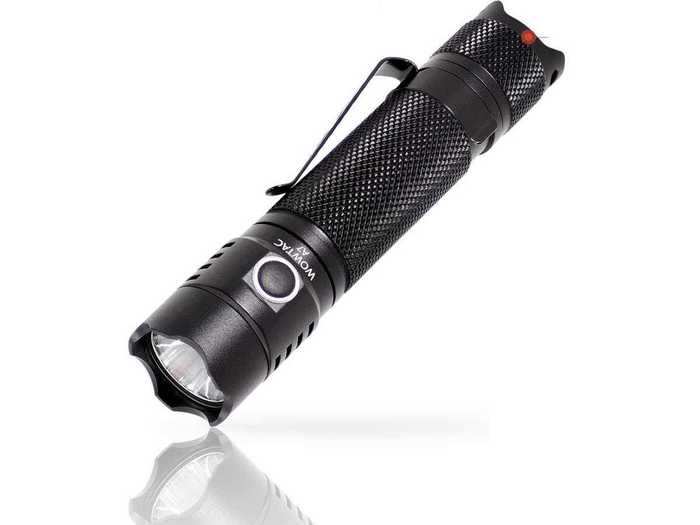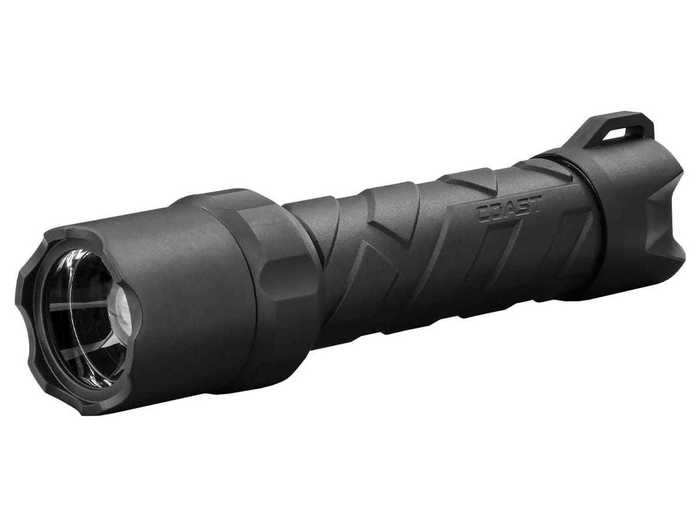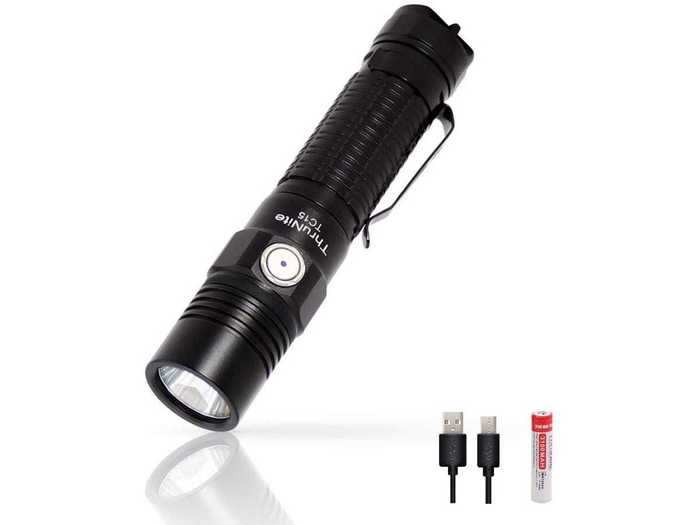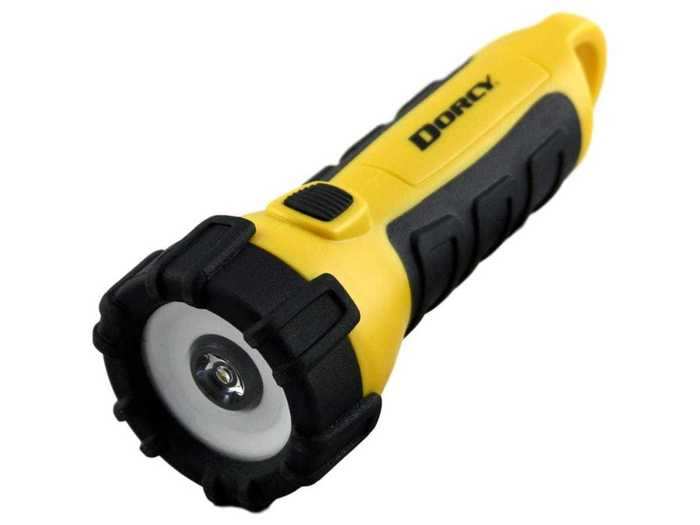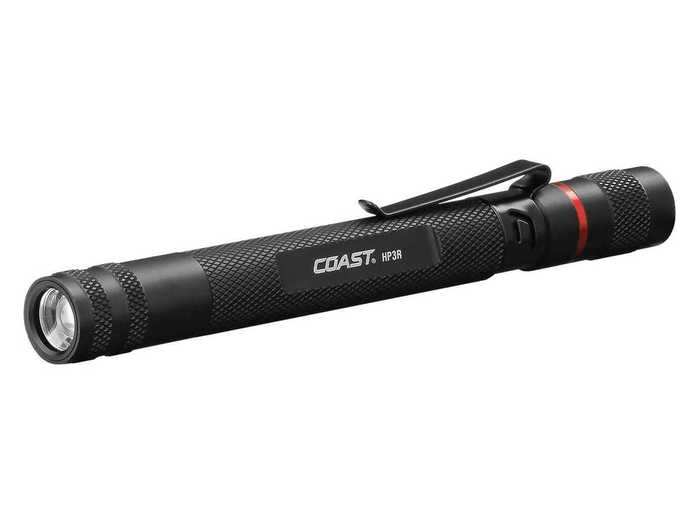- A high-quality flashlight offers a variety of beam modes, maintains its brightness, and has a long-lasting battery that's easy to recharge or switch out.
- For this guide, we field-tested a variety of flashlights and included those that performed well over several hours, offer useful features that justify their price, and are designed to take a beating.
- Our top pick, the Wowtac A7 Tactical Flashlight, passed our durability tests, performed well in terms of overall brightness, and was one of the most affordable options we looked at.
Everyone needs a good flashlight. Even if you don't camp, use one professionally, or ever go out at night, a bright, reliable flashlight is an essential part of emergency preparedness and just plain handy to have around the house. If the power ever goes out, each family member needs a light to guide them to safety. Fortunately, these useful tools have come a long way in the last decade.
"The transition many years ago from incandescent bulbs was a huge leap forward," Jake Keller, head training advisor for the Multnomah County (Oregon) Sheriff's Office Search & Rescue Team told Business Insider. "LED lights help extend battery life and durability and require fewer battery changes. The technology continues to improve, and now you're seeing things like low-level red lights incorporated into a normal light, as well as more rechargeable options."
Since LEDs dominate the industry of late, and remain superior to older models, the flashlights featured in this guide are only of the LED variety. This isn't to say older models aren't still feasible options but when boiling it down to the best, LED wins in every category.
How to shop for a flashlight
When choosing a flashlight, there are a number of factors Keller recommends considering: "In an everyday carry application, I look for something small that easily fits into a pocket. I'd sacrifice an adjustable focus and battery life in favor of something small, bright, and quick to use."
During my tests, I paid special attention to brightness, ease of use, and size, but since different users have diverse needs, I also looked at battery runtime and adjustable focus abilities. For instance, if you're on a hiking trip, you may not have easy access to a charging port and may not want the added weight of extra batteries. This is where a longer battery runtime comes in handy.
How we test
There are several tests I put each model through to thoroughly review each option. The most important factors to consider are performance, lighting options, and battery power.
Brightness: I used a light meter and an old mattress box to measure the lumens of each flashlight. I cut two holes in one end of the 42-inch-long box (one hole for the flashlight to shine through and another for the light sensor). I then covered the interior with white paper and measured the lumens of the reflected light with the flashlight set to max brightness and a wide beam. I recorded measurements every 10 minutes for an hour and a half. This showed both the brightness of the reflected light and how that changed over time. For most models, the lumen output decreased by at least 50 percent in the first 10 minutes.
Battery power: After the 90-minute brightness test, I let each battery operate on high until it was out of juice. Though a few still produced a dim light after a few hours some put off a marginally bright light for days. I also looked at whether the flashlight used common batteries (i.e., AA or AAA) that are easy to replace or if it used a popular charging cord in the case of rechargeable batteries.
Light modes: How many brightness options are there? Are there other colors or functions, such as strobe or SOS? Is it easy to switch between the different modes? These are all questions I considered when examining each flashlight.
Durability: You don't want your flashlight to break easily. To test durability, I dropped each flashlight from 10 feet above a flight of hardwood stairs. None of the flashlights broke but the light went out on a few of them, which would make it hard to find if dropped in the dark. I also looked at whether they were waterproof or just water-resistant. If waterproof (IPX8), I submerged the flashlight in water for at least five minutes to see if it continued to function normally.
Additionally, I examined whether the flashlights had adjustable focus, were easy to turn on by accident, and how they were to operate with gloves on.
The following recommendations each performed well throughout the tests and proved to have useful features and a durability rating that justify the sometimes high sticker price. I also included some input on other models I tested but that didn't ultimately make the cut.
Here are the best flashlights:
Updated on 8/6/2020 by James Brains: Overhauled the entire guide, included a how to shop for a flashlight section, as well as how we test, picked new products for each category, and updated the links and pricing throughout.
The best flashlight overall
Amazon
The Wowtac A7 Tactical Flashlight is not only one of the most affordable lights we tested, but it's also one of the brightest and most durable.The Wowtac A7 Tactical Flashlight was the clear winner in our tests, led by excellent results regarding our brightness tests. When fully charged, the light was the brightest of all of the flashlights we tested. But after 10 minutes on its Turbo mode, the lumens dropped dramatically. Still, after the 90-minute test period, the A7 was one of the brightest models.
The A7 has five brightness modes including a Firefly mode, which is its dimmest at a reported 0.5 lumens and a battery runtime of 108 days. Turbo is the brightest and is meant for short periods of ultra-brightness. There's also a Strobe mode, which has a high lumen output.
I like that the mode switching button is separate from the on/off button. This lets you easily keep the light set to your favorite mode and not have to cycle through each time you turn it on. Also, the anodized aluminum body (AL 6061-T6) surrounding the on/off button is raised, which makes it difficult to accidentally turn the unit on while it's in a backpack or pant pocket. And, at 4.5 inches long and one inch in diameter, it's easy to stow.
The Wowtac A7 didn't exactly wow during the durability tests as the light went out during the drop test — though it did start working again once I picked it up. The light has an IPX8 waterproof rating, which proved accurate as it handled full submersion without any impact on its performance.
I'd have liked to see a more common battery used in the A7, too. Instead, it operates on an 18650 battery. But, the rechargeable Li-ion Wowtac brand battery that it comes with lasted 10 hours on top brightness. Plus, charging the device is simple with the included micro USB charging cord.
Pros: Very bright, five brightness modes plus strobe, IPX8 waterproof rating, long-lasting rechargeable Li-ion battery, fits easily into a pocket
Cons: Uses an uncommon 18650 battery
The best dual power flashlight
Amazon
The Coast 600R Waterproof Flashlight produces a strong beam of light with adjustable focus whether you operate it using the rechargeable battery or alkaline batteries.When a rechargeable battery runs out of juice, you don't want to sit around for hours waiting for it to recharge. You want to be able to pop in some other batteries — preferably those that are easy to find — and keep the light going.
The Coast 600R Waterproof Flashlight gives you the best of both worlds with a Li-ion rechargeable battery and a separate insert that allows you to operate the unit using 4 AA batteries. Plus, the rechargeable battery powers up using a standard micro USB charging cable that comes with the device.
The performance was also among the best in my tests. While the lumens decreased significantly after 40 minutes of operating on high, the light was still impressive after 90 minutes when drawing on either power source. The performance of the alkaline batteries appears to be better, and the light was still producing a decent beam after more than 72 hours of continuous operation.
At 8 inches long, it's one of the bigger flashlights in this guide, but it's also quite durable. On the drop test, the light didn't go out, though the stainless-steel body did make a small nick in the floor. The IPX8 waterproof rating also checked out.
The beam distance according to the manufacturer is a max of 247 meters, and it has an adjustable focus for when you want to direct your light to a specific spot. There are three brightness modes, which are a little cumbersome to switch through since you not only have to cycle through the modes, but the light also turns off between each mode.
Pros: Operates using either rechargeable or 4 AA batteries, excellent performance in our brightness and durability tests, IPX8 waterproof rating, easy to operate with heavy gloves on
Cons: It's a pain to switch between modes, rolls easily
The best flashlight for long-term brightness
Amazon
If you want a light that starts bright and stays bright for up to two hours, the ThruNite TC15 Ultra-Bright Flashlight is your best bet.The ThruNite TC15 Ultra-Bright Flashlight is a durable and powerful little light. At 5 inches long by 1 inch in diameter, it's small enough to fit in your pocket while its heavy-duty anodized aluminum (T6061-T6) body is IPX8 waterproof resistant and an handle being submerged in water. The flashlight also withstood a 10-foot drop without a problem.
In the brightness tests, the TC15 did an extraordinary job. It just missed out on being the brightest from the start, and it only dimmed slightly over the course of the next hour and a half. It was the brightest by far at the end of the testing period.
There are five brightness levels plus a strobe mode effect. ThruNite warns against running the flashlight on max brightness for more than ten minutes to protect the battery and I found this to be good advice, especially since the light gets too hot to hold when you keep it on Turbo for an extended period.
Though it performed well, there were a few downsides. You need an 18650 battery to operate the flashlight. Fortunately, the TC15 does come with a rechargeable ThruNite brand 3100mAh battery and a micro USB charge cord. Since the light runs so bright, the battery lasted less than two hours on top mode. You likely won't use that high for long, and the dimmer modes lasted much longer.
The last negative is the on/off/mode selector button: It's very easy to accidentally turn it on. Switching between modes isn't intuitive, either. For instance, to engage Turbo mode, you double click the button. For strobe, you double click again. If you don't use the flashlight often, you'll want to keep the user manual handy.
Pros: Very bright, 5 brightness options plus strobe, IPX8 waterproof, handled a drop from 10 feet, 246-meter beam distance
Cons: Uses an 18650 battery, gets incredibly hot after a while on max, power/mode selector button could be better
The best budget flashlight
Amazon
The Dorcy Floating Flashlight is an affordable option that performs surprisingly and is not only waterproof but can float, too.The Dorcy Floating Flashlight is one impressive flashlight that costs less than just $20. It's the only light in our tests that floats, and it can handle being submerged without malfunctioning — though we weren't able to track down an IP rating. The waterproof properties make the light ideal for boats, around the pool, or in other wet areas. Its hard-plastic body is also quite durable passing the drop test with ease.
However, at 6.5 inches long and 2.5 inches in diameter it only fits in larger pockets but does have a clip on the end for easy attachment to your belt loop or a rope.
Another downside is that there's only one brightness setting, though it doesn't dim much over time. After 90 minutes, it was among the top four brightest flashlights in this guide. The Dorcy Floating Flashlight has a manufacturer-reported beam distance of 67 meters and runs on 3 common AA batteries, which are included. And, I found the batteries last for roughly 40 hours of continuous use.
The on/off button is designed to make it hard to accidentally turn it on when you toss it in a bag. This is important because an easily engage on/off button could kill the battery before you have a chance to use your flashlight — which is a major consideration for hikers and backpackers. The button even functioned well when I wore thick gloves.
I also put the flashlight on a 15-percent incline to see if it would roll away, a concern when doing work in uneven terrain. The rubber surrounding the lens kept the Dorcy light in place.
Pros: Affordable, easy-to-use, floats, waterproof, built-in carabiner, long-lasting battery with consistent brightness
Cons: Only one brightness mode
The best penlight
Amazon
The Coast HP3R Penlight is compact enough to keep in your pocket on a daily basis and provides adjustable focus light right where you need it.Due to their compact size, penlights tend not to perform as well as other flashlights. However, if you need a light that directs a bright beam right where you need and is easy to pop into your shirt or pants pocket, the Coast HP3R Penlight does an excellent job.
Based in Portland, Oregon, Coast focuses on LED lights for professionals, such as law enforcement, search and rescue teams, and oil rig workers. Jake Keller, the SAR trainer we interviewed for this article, lists Coast as one of a handful of brands he highly recommends. And, the company backs its products with a lifetime warranty against defects in workmanship and materials.
What I like most about the HP3R is that it operates on 2 AAA alkaline batteries or using the included Li-ion rechargeable battery, which charges using a standard micro USB charging cord. The alkaline batteries (which are included) lasted much longer than the rechargeable (72+ hours vs. 6 hours on high), but the rechargeable batteries produced a brighter beam. Neither power source was particularly bright compared to the full-size flashlights, but thanks to the adjustable lens, you can direct the beam right where you want it — and the beam distance is up to 93 meters.
Though the light is only IPX4 water-resistant, which means it's protected from splashes of water from any direction but can't handle submersion, the anodized aluminum body handled the drop test with no effects on its performance.
The biggest negatives were that the penlight is easy to accidentally turn on, and it takes some practice to get the hang of adjusting between its two brightness options. The mode sequence as you press the power/mode selector button is high-off-low-off-high. However, if the light is off for a few seconds, the light remembers the last mode you were in. So, if you habitually use high brightness, you don't need to cycle through modes each time you turn the light on.
Pros: Dual power – 2 AAA batteries and rechargeable Li-ion, long battery life, adjustable beam focus, passed our drop test, doesn't roll easily
Cons: Limited lighting modes, only IPX4 water-resistant, easy to accidentally turn on
What else was considered
I looked at several flashlight brands and models while researching this guide and the following just missed the cut but are still worth considering.
ThruNite T1 ($39.99): There's a lot to like about the T1. It has four brightness options plus strobe, is made with durable T6061-T6 aircraft-grade anodized aluminum that stood up to the drop test, and it's IPX8 waterproof. Plus, it was the smallest light I tested at just 2.5 inches long, 1 inch in diameter, and 2.5 ounces. It also gets quite bright and maintains its brightness. It wasn't included because it relies on an uncommon 18350 rechargeable battery that has a short runtime. It was also a pain switching between light modes.
ThruNite Archer 2A ($29.99): The Archer 2A is similar to the T1 in a lot of ways: Similar durable body material, same waterproof rating, and the same brightness/strobe modes. The biggest differences are that the Archer 2A is more of a penlight with a body that's 6 inches long and ¾ inches in diameter. And, the 2A relies on 2 AA batteries for operation, which are easier to switch out but didn't perform as well in the brightness tests, which is a big reason why it didn't make it into the guide.
Coast SX300R ($59.99): The SX300R is all about options. It operates using a rechargeable Li-ion battery or 4 AAA batteries. The body extends to access LED lights incorporated into the body with white, red, and flashing red modes. The tail cap features a strong magnet allowing you to stick the flashlight where you want it. It's not included in the guide because it isn't waterproof, the light went out in our drop test, and it's easy to accidentally turn on. However, you might overlook these negatives if you need a good area light.
Anker Bolder LC90 ($29.99): This was one of the top performers in the brightness test starting out bright and maintaining a strong lumen output. It has adjustable focus and three brightness settings, including a strobe and SOS function. Unfortunately, it's a bit cumbersome to switch between the light modes and is easy to accidentally turn on. Plus, it isn't waterproof, rolls easily, and relies on a relatively uncommon 18650 battery.
Headspin ($135.99): If you like camping, you should consider this versatile light. The Headspin has a small base light that attaches to one of four mounts: Headlamp, magnet, bike, and flashlight. I was unimpressed with the rechargeable battery, which can't be switched out and only lasted for 90 minutes on high. To its credit, the lumen output didn't decrease much during the runtime. Also, I didn't like that it isn't waterproof, just IP66 water-resistant.

